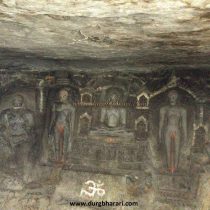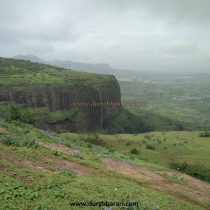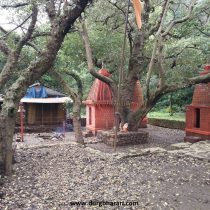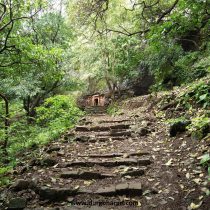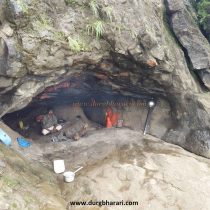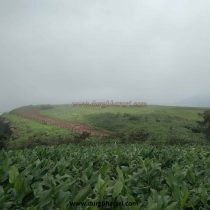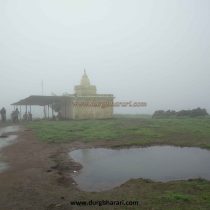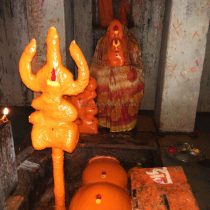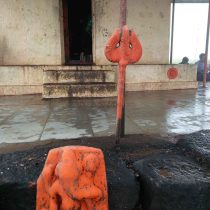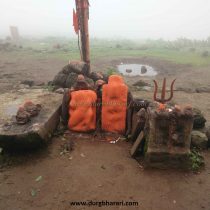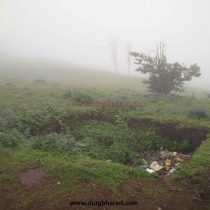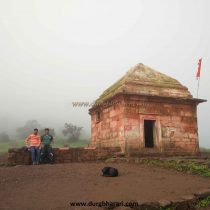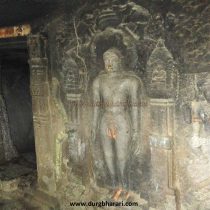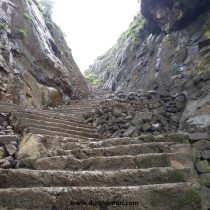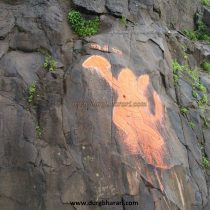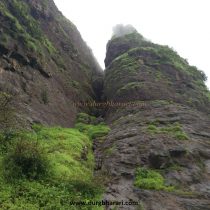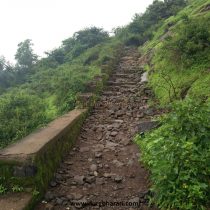ANJANERI
TYPE : HILL FORT
DISTRICT : NASHIK
HEIGHT : 3215 FEET
GRADE : MEDIUM
Nashik district has the highest amount of forts compared to any other district in Maharashtra. History from the Satavahana period begun in this district and mythic stories are related to various mountains in this district. Anjneri fort is the famous Rishyamuk mountain in Ramayan. It is believed that Hanuman, the son of Vayu, was born on this hill and the fort was named Anjneri after his mother Anjani. Anjneri fort, situated at an altitude of 4000 feet above sea level and 2500 feet above the foothills, was an important fort in the Trimbakeshwar range starting from Bhaskargad. Anjneri village at the foot of the fort still has 16 ancient temples and inscriptions, out of which 4 temples are for Hindu deities and 12 temples are for Jain deities. On the Nashik-Trimbakeshwar road, at a distance of 23 km from Nashik, there is a fork of Anjneri village.
...
There is a temple here with a big idol of Hanuman. A path leads to Anjneri village next to this temple. The Anjneri fort generally falls into three parts. The first part is the base of the fort. A dirt road has been constructed from Anjneri village to the base of the fort. The private car can go up to that point. The second part is the fort's machi. There are steps to reach the Anjanimata temple on the plateau. From here, the third part is the citadel of the fort. In the third part, there are steps to go to the fort. A dirt road leads to the fort across the village of Anjneri. Looking at the cones like Navra-Navri and Sasu seen around the fort, we come to the forest department post at the foot of the fort. As you approach the foothills, the vastness of the mountain catches your eye. The fort did not need to be fortified as it has a 90 degrees edge on all sides of the hill except for the south side. The footpath leading to the fort starts from the forest department outpost. The vertical ascent of the fort begins with some old and some new steps. In some places, iron walls have been erected by the forest department for security. Turning to the base of the bridge, we reach the middle of the facade and the Anjneri plateau. On the way to the valley, there is an idol of Hanuman painted on the rock. At this stage of the climb, there is a narrow path 10 feet above the ground to reach this cave. This is the cave of Parshvanath Digambar Jain 1008. There are two pavilions in this cave and inside the outer pavilion there are sculptures of Bhairav and Hanuman and a lotus flower of half a meter diameter is carved on the roof. The entrance of the cave is carved with serpentine, kirtimukh, and other geometric figures, while both the limbs have a gatekeeper structure. In the inner hall, there is a half meter high sculpture of Parshvanath in the middle and Padmasana and ten other idols on both sides. Next to this sculpture in the sanctum sanctorum is a Sanskrit inscription which gives information about this cave. A donation was made to the cave in 1141 by the minister of King Saundev. The relationship between caves and forts carved from the royal palace can be seen here as well. On the side of the cave is a water tank carved into the rock. After seeing these caves and climbing the remaining steps, we reach a wide plateau. In front, you can see the magnificent citadel of Anjneri fort. The Machi area of the fort is a magnificent plateau. At Machi, where you enter the fort, you have to look for the remains of the broken ramparts and gates on the lower side. Remains of many structures are scattered on this plateau of the fort. After walking on the footpath from Machi to the citadel, we reach the Anjani Mata temple in 15 minutes. The Anjani Mata temple is spacious and suitable for staying. The temple has a new set up idol of Anjani Mata and Hanuman in front of it. There are two water tanks in front of the temple and one on the right side of the temple but both the tanks are dry. There are two shops of food and worship materials near the temple. Meals are served here. The same path from Anjani Mata's temple leads to a large lake. This lake is known as Hanumantale and Indrakund. This is the arrangement of drinking water on the fort. This pond is filled with water throughout the year. Many houses can be seen on its banks. The wheel of limestone used for this construction is also lying here. Going a little further from here, it takes two paths to reach the base of the fort. The path from the lake on the right leads to Anjaneri's citadel, while the path on the left leads to the dense bush to the ashram at the plateau and to the Sita Cave. We would first take the left footpath and walk towards the ashram. There are small temples of Hanuman, Ganapati, and Datta recently built in the ashram area. The path leading to the ashram leads to the Sita cave carved in the rock. The Sita cave is carved in the vicinity of the fort and it seems that a family is standing in the role of gatekeeper on both sides of the entrance of the cave. The cave has two halls and many sculptures are carved on the walls of the cave. The quality of these sculptures suggests that they may have been carved in later times. It is believed that Anjani gave birth to Hanuman in this cave. After exploring the area around the ashram and Sita cave, we come back to the lake and from the right side, we start our journey towards the citadel. This path is a rocky climb and the forest department has put up railings here. After climbing the hill of the citadel to a height of about a 3/4, a footpath on the left leads to a cave. On that road is a sign saying Hanuman's birthplace. Going further along this path, you can see a wide cave. There is a bell hanging on a tree outside the cave and there is a Gada of Hanuman near the cave and a stone-like idol of mother Anjani in the cave. This cave must have been used for surveillance. If there is a camping trek, 10-12 people can stay in this cave. At present, a sadhu is residing in this cave and he has also made a water tank in front of the cave. After seeing the cave and coming back to the steps, we reach the plateau of the citadel. The citadel’s Machi is like a plateau. After walking for 10 minutes from the plateau, we reach the temple of Hanuman. In this temple, Bal Hanuman is shown sitting on the lap of mother Anjani. There is a water tank on the side of the temple. There are some idols and objects in front of the temple and the open space next to it and behind the temple, there are some squares relics. This is where your exploration ends. The extension of the fort is huge and there are no other relics on it but the surrounding area looks very beautiful from here. It takes two hours to reach the citadel from Anjneri village. The nearby Brahmagiri hill and fort Durgbhandar are visible from above. Behind Bramhagiri are the forts of Harshgad and Basgad in the Trimbak mountain range, while the forts of Bramhadongar and Utvad are visible. On the other side, there are many forts like Ranjangiri, Gadgada, Bahula, Waghera, Songir, Khairai. It takes 6 to 7 hours from Anjaneri village to walk around and see the entire fort properly. During the day, meals are served at the fort by the locals, but they do not stay at the fort at night. When searching for the history of Anjneri fort, one has to consider the past of Anjaneri village which was originally at its foot. Anjneri has been a politically important center since ancient times. The importance of this area increased during the Yadav period. Remains of this ancient period are still found in the village. There are sixteen ancient temples of Hindus and Jains in Anjneri. The fort must have been built to protect the ancient city of Anjaneri. Considering the ancient excavations on the fort and the temple complex at the foot of Anjneri, this fort must have been a delight since the time of Rashtrakut-Chalukyas. It is inscribed in the Pandavleni that Anjneri was the capital of the Abhir Gawli king Ishwarsen (Veersen) who ruled in this area around 260 AD. Their silver coins are also available. Apart from this, two copper plates found in Anjneri area. It is mentioned that in 710 AD, the Harishchandra dynasty of the Chalukyas of Badami was ruling. The copperplate of 710 AD mentions taxes levied on villages in the area for various temples near Anjneri. During the reign of the Yadav kings at Sinnar, Seunchandra III ruled the Konkan from Anjneri for some time between 1130 and 1145 AD. An inscription of 1141 AD is available in his career. Anjneri and the area were called Shwetaprad in the Jain tradition. During the Yadava period in the 10th-11th centuries, caves were carved in many places in this area. Anjneri is also mentioned later during the Muslim rule. From 1508 to 1553, the fort belonged to the Burhan Nizam of Ahmednagar. It is mentioned that the Nizamshahi kept the minor Nizamshah safe on this fort for some time. During the Shivaji Maharaj’s period, Moropant Pingale in October 1670, brought the Anjneri fort under Swarajya along with Trimbakgad. Anjneri fort is mentioned briefly during the Mughal-Maratha conflict. Later in 1750, the fort came under the control of Nizam. During the Peshwa period, Raghobadada built a mansion on the fort for his stay. After the Marathas, British officials also used to come to stay at the fort in summer due to the cool flow of air in the surroundings. The remnants of a bungalow built by the British can be seen on the banks of Hanuman Lake.
© Suresh Nimbalkar

